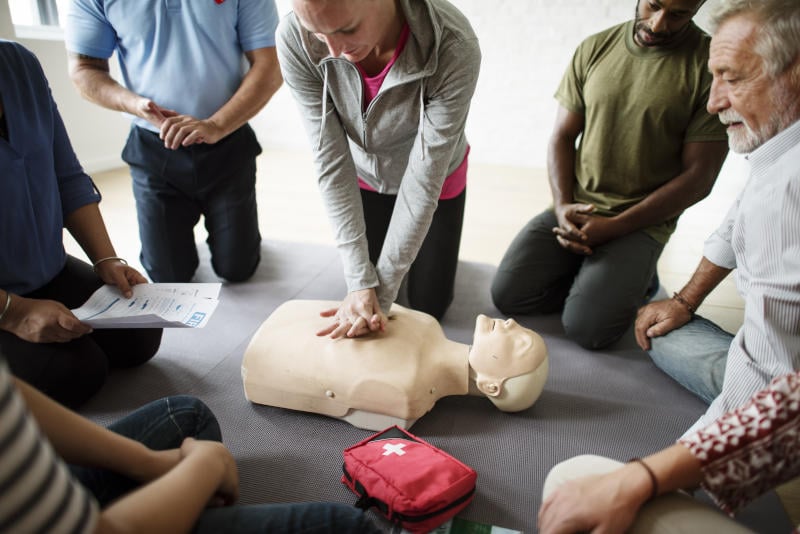When it comes to training your group or organization in CPR, understanding which class type will be the best fit for everyone involved is essential. With online, classroom, and blended options available, it can be difficult to decide which is the best fit for your needs. But with the right information and insight, you can choose an option that works for everyone.
We’ll delve into the differences between these three methods so you can decide which one makes sense for your unique situation. From learning styles to group availability, budgets and more, we’ll give you the full picture on how choosing a training modality should take shape. Read on to learn more!
The 3 Class Types: Online, Blended, and Classroom
There are three main class types to consider when selecting a course: online, blended, and classroom. Online learning has become increasingly popular due to its accessibility and flexibility, while the traditional classroom setting allows for direct interaction between students and teachers. Finally, blended learning combines online and hands-on instruction.
In recent years, online CPR courses have become a viable option for those looking to become certified in lifesaving skills. These courses offer the convenience of being able to learn at your own pace and on your own schedule, while still receiving the necessary training to potentially save a life. They also tend to be more affordable than in-person or blended classes, which makes this important training more accessible to the general public.
However, in-person classes will always have a place due to the hands-on training that they provide. Many people will always gravitate towards the traditional classroom setting, and this option will not be going away any time soon.
Blended classes are the best of both worlds. They provide aspects of both online and hands-on classes, creating a hybrid solution for the modern age.
Regardless of which learning modality you choose, it’s important to find one that works for your individual needs and goals. Remember: the most important thing is simply making CPR training a part of your life.
The Pros & Cons of Different Class Types
CPR, or cardiopulmonary resuscitation, is a crucial skill that can save lives. With the development of technology, there are now different ways to learn this life-saving technique.
Online CPR courses are popular for the convenience and flexibility they offer. They are easy to sign up for, can be done on your own time, and often come at a price point that is lower and more accessible, which makes this important training broadly available. However, online classes are sometimes criticized for their lack of practical, hands-on experience.
Classroom courses, on the other hand, offer in-person instruction and the opportunity to practice with a certified instructor. This experience, however, can be overshadowed by the expense and inconvenience of fitting an in-person class into an already-hectic schedule. The time and expense can cause people to delay signing up for a course, and that procrastination can lead to never becoming CPR certified.
Blended courses can offer the best of both worlds by combining online learning with hands-on practice. However, it can be hard to know if a course will offer a balanced blend, or if it will lean predominately one way or another.
Ultimately, the choice of CPR course depends on personal preference and schedule flexibility. Any one of the options will provide the needed training – and with the right training, anyone can be prepared to effectively respond in an emergency.
Which Type of Students Each Program Is Best For
With so many different types of CPR programs available, it can be tough to decide on a personal level which one is best for you. Each program has its own unique advantages, depending on the type of student you are.
For those who prefer flexibility and convenience, or for those who learn best by reading and listening, an online CPR program may be the ideal choice. However, if you thrive in a hands-on learning environment, a classroom-based program could be the preferred option. For those who want to combine flexibility with in-person instruction, a blended CPR program could be the perfect choice.
No matter which program you choose, the important thing is to begin your training so you’ll be prepared to save a life.
What’s Best for Your Organization?
When choosing a CPR training program, different companies and organizations have different needs and objectives, and therefore may benefit from certain programs more than others.
For instance, healthcare providers, such as hospitals and clinics, require a more advanced program like Basic Life Support (BLS), which covers advanced airway management, pharmacology, and other complex components of CPR. BLS and other employment-required programs often require a hands-on skills evaluation, which means a blended program may be ideal for your organization.
On the other hand, schools and workplaces may opt for a simpler and quicker basic CPR programs, which focus on hands-only CPR and can typically be done with an entirely online program..
Regardless of the program, it is crucial for organizations to ensure that their employees receive proper CPR training in order to prevent fatalities and promote safety in their respective environments.
The type of CPR program you use will depend on the needs of your group, whether students or employees. Online CPR is helpful for groups of any size, while blended and classroom training can provide a more hands-on experience for smaller groups. If time is an issue, then online may be better suited to your group’s needs. If in-person training is a priority for some of your members, then classroom or blended learning would be the preferable options.
No matter which method you decide on, all are designed to help prepare participants for successful, life-saving endeavors. ProTrainings offers online, blended, and classroom options, so you can learn in the way that is best for you. Choose the best fit for your individual or organizational needs and get started on your CPR certification or renewal now!

